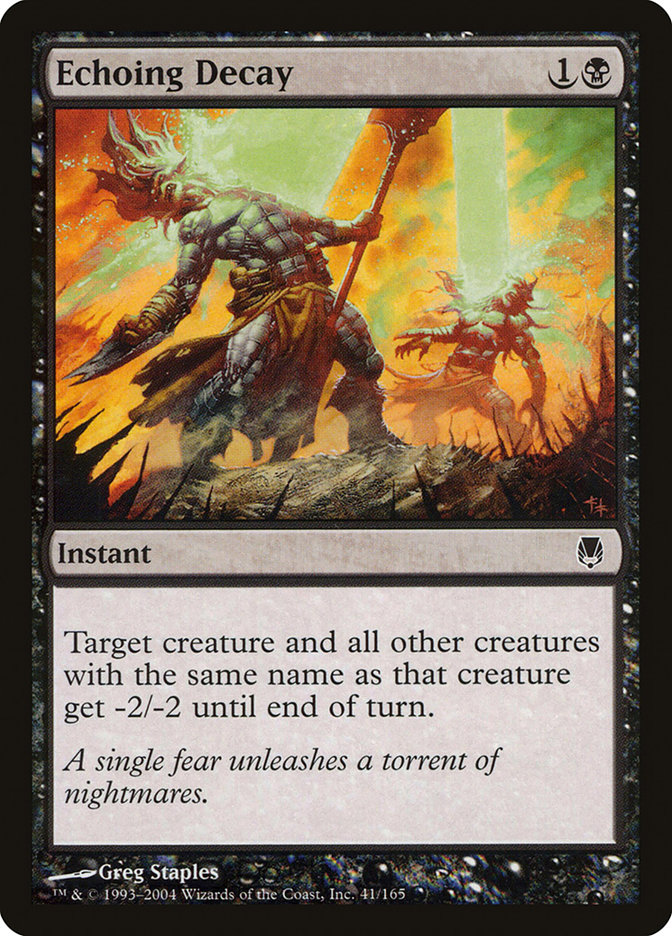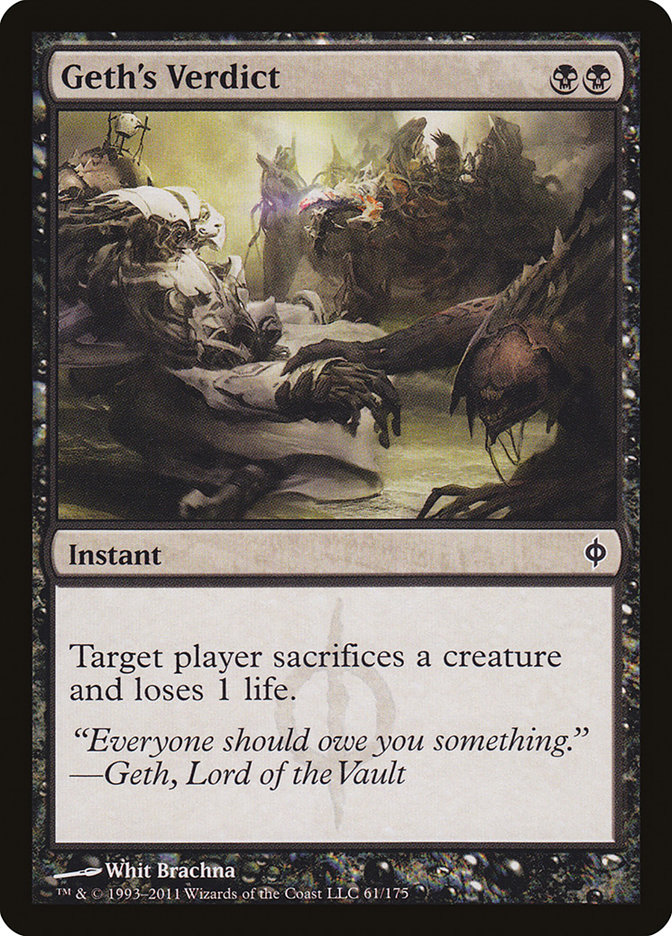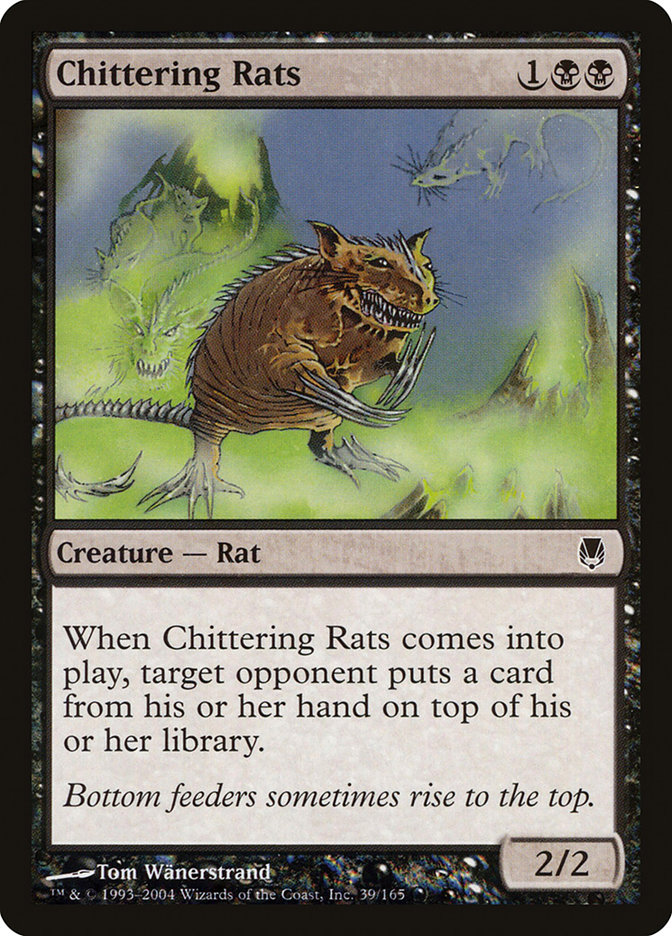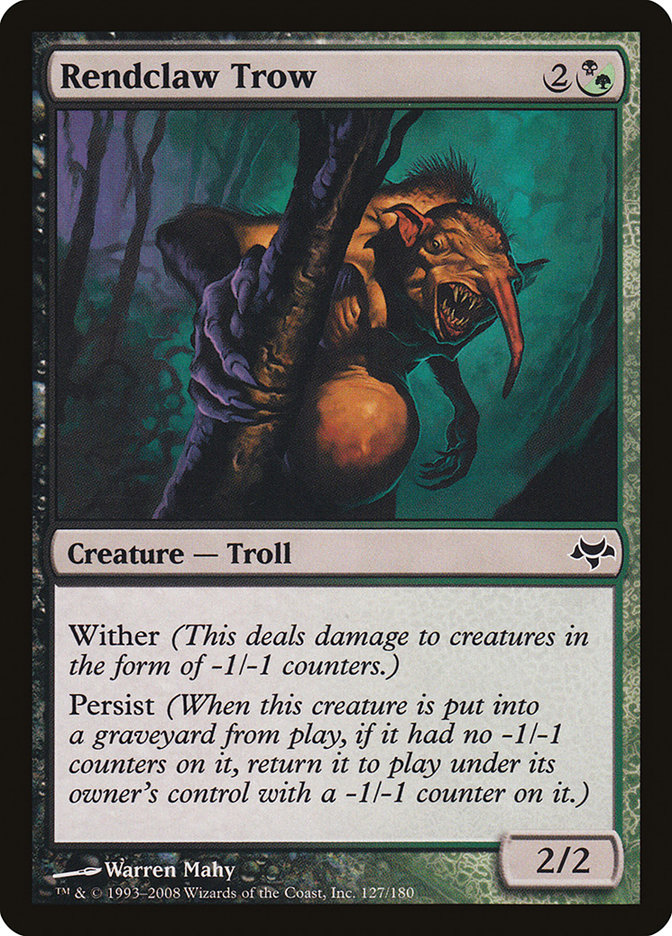Black control is the Holy Grail for many rogue deckbuilders. Every set release ushers in the same tired cries of "Mono-Black Control is back!" Sometimes the deck shows up for a week, maybe two. Even now there are control decks that use Swamps, because hey, Overgrown Tomb counts. But those exultations turn into the screams of the damned soon in the weeks after a release because black control is rarely a thing anymore.
Except in Pauper.
In the land of commons, Mono-Black Control has been a player since day one. With a history of strong commons, if you want to play in peat, play Pauper. I explored the concept of black control early in my time at this here site, but here is a brief refresher.
Pauper is largely a creature-based format (even the current combo decks make use of creatures), so black’s propensity for killing things becomes a valued attribute. The fact that it also has disruptive creatures with reasonable (read: at least two) power means that black decks can harass opponents while also presenting threats. These aspects are tied together with the draw of Sign in Blood to create a cohesive deck.
Mono-Black Control (hereafter MBC) has not been a stagnant entity in Pauper. In its earliest form, the deck gummed up the ground with Ravenous Rats, Chittering Rats, and Phyrexian Ragers whilst picking off threats before ending the game with one or two large Corrupts. The key spell to this was Tendrils of Corruption, which would kill a creature and undo one to two attacks with the life gain. This gain in tempo was so good that it led to Goblins leaning heavily on Mogg Raider / Goblin Sledder (which turned off the life gain) becoming the best aggressive deck. Thereafter, Pauper became a speedy format where relying on getting to six for chaining Corrupts is no longer a reasonable proposition.
MBC went underground for a while, like all great ones do, and reemerged as a sleeker, svelter deck. Gone is the end game of Corrupt; game-ending fatalities are now the province of Cloudpost decks. Instead, MBC kept the Rats, the discard, and the removal. It is faster, stronger, better. My preferred weapon looks like this:
Creatures (19)
Lands (23)
Spells (18)

Dead Weight may seem like an odd choice over Disfigure, but it actually has some serious advantages. Dispel sees a decent amount of play, and being able to take out a Delver of Secrets, Atog, or just about every creature in Pauper without having to play around another counterspell can be huge. Taking the teeth out of other creatures is almost as good, allowing the Rats to brawl effectively.
Echoing Decay might be a "worse" Grasp of Darkness most of the time, but most creatures in Pauper are on par with bears. Echoing Decay allows two (or better)-for-ones while also messing with combat math. Notably, it can remove a swarm of Cloud of Faeries, which puts a serious downer on Temporal Fissure Storm’s plan. Two is the right number, especially since there are no longer huge armies of Goblin tokens running around.
Geth’s Verdict gets around that nasty targeting liability. Decks are fond of bringing in Standard Bearer or Guardian of the Guildpact or (insert hard to remove threat here). The Verdict does not care. Combined with the other removal available, it is not hard to make sure the creature you want to hit with Geth’s Verdict goes away.
Finally, Crypt Rats, aka the best Wrath of God in Pauper. This card is well positioned right now, dealing with both combo decks (Temporal Fissure and Elves) almost singlehandedly by taking out their combo pieces. Crypt Rats also allows you to craft the game with the knowledge you have access to an X spell. Now, you don’t have to deal all the damage with 1/1s and 2/2s. Instead, you can play small and nibble away at an opposing life total, keeping yours just high enough to win with a Crypt Rats activation.
There is one interface trick that is important to remember with Crypt Rats. When dealing with creatures that have undying or persist or leave behind a token, you want to hold the "control" key while activating Crypt Rats—this will maintain priority. For the first activation, pay enough to kill whatever is left behind; for the second, pay just enough to kill what is on the board right now.
Example: to kill a Young Wolf, you would want the first activation to be for two and the second to be for one. For Safehold Elite, this would be reversed.
What’s missing? Doom Blade and Victim of Night are both perfectly reasonable answers, but they have some important restrictions. Black decks represent a non-zero portion of the metagame, and having a spell that can’t do its job all the time is not worth a slot. Victim of Night could find a home, but it is largely dependent on how the metagame swings. With Nivix Cyclops being a dominant aggressive strategy and packing Apostle’s Blessing, relying on targeted removal is risky (although Victim does make for a solid sideboard inclusion, as seen below).
Chittering Rats and Phyrexian Rager should not surprise anyone—they are two of the best value three-drops in the format. The presence of both creates a subgame; with access to both, which one do you play?
Sometimes, the answer is easy. Need to draw a card? Play Rager. At one life? Better play Chittering Rats. Most of the time, it’s a more difficult proposition. Let’s say you’re up against Affinity and are at a reasonably healthy fifteen life. Your opponent just played out two Frogmites and a Myr Enforcer, leaving them with two cards in hand (and multiple mana sources), and you have five Swamps in play after making your land drop for the turn. You have a Phyrexian Rager and Chittering Rats in hand. Given this situation, I would almost definitely run out Phyrexian Rager. Chances are the cards in hand are both Galvanic Blasts (if they are not blanks), and you are in a position where you need to draw removal.
Chittering Rats is far more effective when you absolutely need to deny a draw step. Looking at the above example, let’s pretend that all of Affinity’s blue sources are spent. Holding two cards signals a Thoughtcast and something else. Denying a draw there is huge, effectively turning Thoughtcast into a draw one.
There is no hard and fast rule, but my guidelines is if a topdeck can kill you, cast Chittering Rats. If you need to topdeck or to advance your position, go for Phyrexian Rager. There are always exceptions, and the best way to decide which one to cast is the same way to play Carnegie Hall: practice practice practice.
The split between Ravenous Rats and Augur of Skulls might look odd, but it plays well. Ravenous Rats is better in the early game as it will absolutely nab something while also being a speed bump. Augur becomes more valuable as the game goes on and can be backbreaking when combined with other discard. Augur also forces opponents to spend cards that they might otherwise want to hold on to for fear of losing them.
Speaking of, two Duresses might seem low, but the card has a rather high rate of diminishing returns. The best combo deck in the format operates on creatures (something we are already strong against), and control is not incredibly prevalent. However, there are times when you want to know what they have and need to take a potentially game-wrecking card. Having two Duresses main and one in the sideboard is the right split. Okiba-Gang Shinobi helps to lessen the blow—a Blightning every turn (often with an additional discard or card draw tacked on) is quite good and can be backbreaking.
Finally, the mana. Sure, running Swamps is obvious, but the Barren Moor / Polluted Mire count hits the sweet spot. While Barren Moor is the card that wants to be cycled more (and therefore is less likely to end up in play), it actually makes sense to run more Moors than Mires since the Onslaught land can be cycled for less. For this reason, it makes sense to play out Polluted Mires first. Once you have six lands in play, for the most part it is safe to start cycling away lands.
This deck plays very differently, at least in game 1, from the older incarnations of Mono-Black. Rather than sculpting an endgame towards Corrupt, the end game in Rats relies on a combination of Crypt Rats and beating down with 2/2s. The big difference between Corrupt and Crypt Rats life total is in the former your life total only needed to be above one and with Crypt Rats you need to keep it as high as possible. Drawing a Crypt Rats late might be the miracle you need, but it is no Bonfire of the Damned and it will hurt.
The other axis that Rats wins on is by having the last 2/2 standing—this is where Unearth shines. Often it is correct to hold on to the mini Zombify until you are reasonably sure that your Phyrexian Rager will be the last creature standing. Other times you will value Unearth to nab the last card or set up a massive stripping of the hand with Augur of Skulls.
Sequencing removal is also an important aspect of playing this deck. Early in the game, picking off utility creatures is far more important. It is only as the game progresses that you want to take out the offensive threats. The exception to this is Atog, which is a kill on sight since it goes from "ho-hum" to "lethal" in the blink of an eye. I tend to prioritize my removal thus: use Dead Weight First then Echoing Decay and hold Geth’s Verdict for when I can be sure to hit what I want.
All of these tips are important in game 1 because the sideboard of this deck is a masterpiece. With a few key additions and subtractions, this deck can transform into a variety of options, including old school tap-out Mono-Black. Rather than provide=ing a sideboarding guide, I am going to copy people like [author name="Adrian Sullivan"]Adrian Sullivan[/author] (who is copying Brian Kowal and Gerry Thompson) and just discuss the decks against which different cards will see play.
Choking Sands is a nice Stone Rain effect with the upside of Shocking the opponent. The non-Swamp rider is largely dead text as the decks you want to hit with it run Cloudpost and cards like Azorius Chancery. If a deck is running lands that produce more than one mana, this will come in. If a deck also seems to be leaning heavily on Guildgates (which is not likely), I could see bringing this in if the matchup is about tempo.
The former game ender, Corrupt, comes in when you need to go over the top. Largely for the mirror and other non-counterspell-based control, Corrupt provides a way to end the game. With this in your deck, your new game plan becomes stay alive long enough to resolve a Corrupt that wins you the game or puts you so firmly in the driver’s seat your opponent will need a crowbar wielded by Rob Castellon to pry you loose.
With two main, a third Duress comes in from the board when you absolutely want to see one in the early game. Most often this is against Temporal Fissure combo, but the card has use against Delver of Secrets decks as well, providing information while nabbing important spells from their hand. Okiba-Gang Shinobi plays a similar role, and these two cards tend to come in together. Against Temporal Fissure and Cloudpost decks, having your Blightning machine active on turn 4 helps to keep the decks in check.
Snuff Out, Sorin’s Thirst, Tendrils of Corruption, and Victim of Night all help to shape your deck against particular opponents. Need more time against hyperaggressive decks? Bring in Tendrils of Corruption and Sorin’s Thirst. Want to be able to kill something not matter what? Better bring in Snuff Out and Victim of Night. The presence of these cards allows you to adjust the dials on your removal suite—the spells main are there because they are good against everyone. The spells here are strikeouts or home runs—they either go a long way towards a win or are stranded.
Finally, my favorite card in the sideboard is Rendclaw Trow. The Troll may not look like much, but it is a source of tempo and card advantage. In a format where creatures matter, getting two for the price of one is huge. My love of undying creatures is well known, but grandpappy persist isn’t bad either. Getting a 2/2 with wither and a 1/1 with wither (albeit split over multiple turns) for three measly mana is very good. Wither is very strong if the format is largely defined by creatures. Blocking and absolutely trading with a Kiln Fiend or Atog is key in the current Pauper landscape, so Rendclaw Trow acts as a Dead Weight on legs. The fact that is comes back for seconds is just gravy. It also does a great job of trading with one of this deck’s archnemeses: Guardian of the Guildpact. Finally, it is just a darn good attacker.
All that being said, this is but one way to build Rats. If you look over the results of various Daily Events, you might notice some other commonly played cards missing from this 75. Here are some other options:
Cuombajj Witches are quite the anti-aggro tool. With the body of a Bane Alley Blackguard and a pseudo Fireslinger ability, Witches does a great job at holding off opposing X/1s. The issue is that the downside is pretty significant when all your creatures are X/2s or smaller. Crypt Rats fills a similar role but also does a better job of ending the game.
Liliana’s Specter is a reasonable include, but the deck is already very choked at three. With a similar effect at two in Ravenous Rats, it does not seem worth it with cards like Scattershot Archer and Cloud of Faeries being common includes.
Spinning Darkness might seem like a sweet addition, being "free" and all. The free cost is rather high in this deck, seeing as how important mid- and late-game Unearths can be. I would sooner run the second Sorin’s Thirst than the first Spinning Darkness.
Grim Harvest is a sideboard card that I love for those long drawn-out matches. Here it would seem a little out of place. Unlike other black decks that want to draw out the long games, Rats wants to slam the door with Augur of Skulls and Okiba-Gang Shinobi. While Harvest is not antithetical to this plan, it is a 76th or 77th card.
There you have it: an update on one of the most enduring and endearing archetypes in Pauper. In the world of commons, Swamps are very well positioned thanks to their propensity for casting spells that kill things. But don’t call it a comeback—black control never left in the first place.
Keep slingin’ commons-
-Alex
SpikeBoyM on Magic Online
https://www.facebook.com/nerdtothecore (new!)
The Colors of Pauper: W U B R G
Discuss Pauper on Twitter using #MTGPauper





